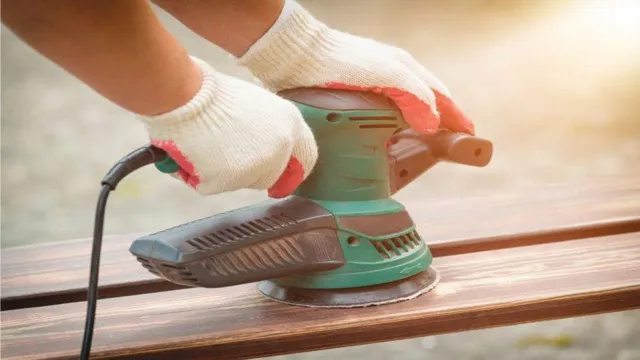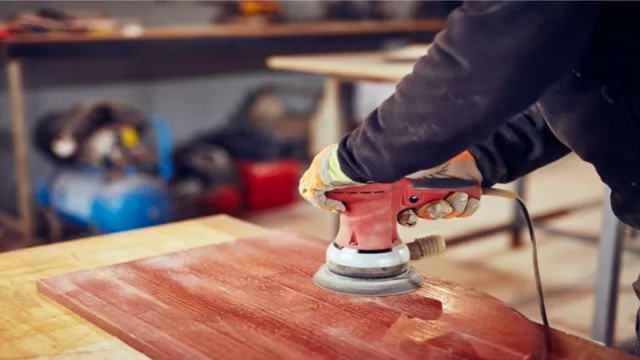How to Get Rid of Orbital Sander Marks: Top Tips and Tricks

Have you ever been in the middle of a woodwork project only to realize that your orbital sander left visible marks all over your wood? It can be frustrating and disappointing, especially when you’ve put in a lot of effort to create a professional-looking finish. But don’t worry, getting rid of orbital sander marks on wood is possible. With the right techniques and tools, you can restore your wood to a smooth, seamless finish.
In this blog post, we’ll dive into some effective methods to remove those pesky marks and give your project the flawless finish it deserves. So let’s get started!
What are Orbital Sander Marks?
Orbital sanders are an essential tool for anyone looking to achieve a smooth, even finish on wood surfaces. However, it is inevitable to experience orbital sander marks during the process. These marks are visible swirls or circular patterns left behind by the sander, and they can be frustrating to deal with.
Luckily, there are ways to get rid of these marks and achieve a flawless finish. One method is to gradually increase the grit level of sandpaper used to remove the marks, starting with a low grit and ending with a high grit. Another technique involves sanding in a diagonal or circular motion rather than following the grain of the wood.
The key is to take your time and use a light touch, as excessive pressure can exacerbate the marks. By following these tips, you can achieve a beautiful, professional-looking finish without any pesky orbital sander marks.
Explanation of Sander Marks and Causes
Orbital sander marks are swirls or circular scratch patterns left behind on wood or other surfaces after using an orbital sander. These marks are caused by the movement of the sander pad, which spins in a circular motion, while the sanding disk moves in an elliptical orbit. The combination of these two motions creates unique patterns on the surface that can cause unsightly marks.
Factors contributing to sander marks include poorly adjusted sander speed, applying too much pressure on the sander, using low-quality sandpaper, and selecting the incorrect grit sandpaper. To avoid these marks, it’s essential to properly adjust the sander speed, use the appropriate grit sandpaper, and apply a consistent amount of pressure while sanding. Orbital sander marks can be frustrating, but with the right techniques, they can be minimized, resulting in smoother and more evenly sanded surfaces.

Preventing Orbital Sander Marks
If you’re a DIY enthusiast, you know that an orbital sander can be a lifesaver when it comes to sanding down rough surfaces and preparing them for staining or painting. However, if you’re not careful, you might end up with unsightly marks or swirls that can seriously detract from the finished product. Fortunately, with a few simple tips, you can avoid getting those orbital sander marks altogether.
Firstly, make sure you’re using the right grit sandpaper for the job. If you start with too coarse a grit, you’ll not only make your job harder but also increase the likelihood of sander marks. Secondly, don’t push too hard on the sander.
Let the machine do the work, and use gentle, even strokes. Finally, take your time and sand in a pattern that ensures even coverage. By following these three tips, you can skip those unsightly marks and enjoy a smooth, professional-looking finish every time.
Proper Sanding Techniques and Tools
When sanding a surface, it is important to use proper techniques and tools to prevent orbital sander marks. One of the best ways to prevent these unsightly marks is to use a fine-grit sandpaper and to avoid applying too much pressure on the sander. It’s also a good idea to sand in a circular motion, rather than back-and-forth, to promote a smooth and even surface.
Using a sanding block can also help prevent accidental pressure buildup, which can lead to marks. Remember, sanding is about precision and patience, so take your time and don’t rush the process. Using quality tools and materials will also help ensure a flawless finish.
With the right techniques, you can achieve a professional-looking surface that is smooth and free of orbital sander marks.
Choosing the Right Sandpaper Grit
When it comes to sanding with an orbital sander, one of the biggest challenges is avoiding visible sanding marks on the wood surface. Preventing these marks requires a combination of the right grit sandpaper and proper sanding technique. Choosing the right sandpaper grit is crucial in achieving a smooth finish without any marks.
Generally, the higher the grit number, the finer the sandpaper. A lower grit sandpaper, such as 80 or 100, is useful for removing heavy varnish or paint, while a higher grit such as 220 or 320 is ideal for final smoothing and preparing the surface for finishing. It’s important to use the right grit for each step of your sanding process.
Additionally, proper sanding technique is also essential in preventing sanding marks, including avoiding tilting the sander and using a light touch. With the right grit sandpaper and proper technique, you can achieve the desired smooth finish on your project without any visible sanding marks.
Removing Orbital Sander Marks
If you’ve recently used an orbital sander on a piece of wood, you may have noticed unsightly marks left behind that can ruin the otherwise smooth surface. Don’t worry though, getting rid of these marks is relatively easy. The first step is to make sure that you have the right sandpaper or abrasive pad on hand.
Start with a coarse grit, like 120, and work your way up to a finer grit, like 220. Next, run your sander over each of the marks, taking care to go in the same direction as the grain of the wood. Don’t apply too much pressure, as this can cause more marks.
Once you’ve removed the marks, do a final pass over the entire surface with a fine grit sandpaper to achieve a perfectly smooth finish. By following these simple steps, you’ll be able to get rid of those pesky orbital sander marks and be left with a beautiful piece of wood.
Sanding Off the Marks
Removing orbital sander marks can be a challenging task, but it’s an essential step when you want to achieve the perfect smooth finish. Typically, orbital sanders leave swirl marks on the surface that may ruin the appeal of your project. Sanding off the marks requires patience, the right tools, and techniques.
To begin with, you need to prepare the surface by cleaning it thoroughly and identifying the scope of the imperfection. Next, use progressively finer sandpapers, starting with coarse grit and working your way up to a smoother finishing type. You can also use a sanding block or a foam pad to eliminate the marks.
Working slowly and using a light touch is crucial to avoid causing further damage to the surface. After sanding, it’s essential to inspect the surface for imperfections, get rid of any dust, and apply a finish coating. By following these simple steps, you can achieve a perfect finish that enhances the appearance of your woodworking project, ready for display or use.
Using Filler and Sanding Sealer
When using an orbital sander, it’s common to leave behind visible marks on the surface that can be frustrating to deal with. Luckily, there are solutions to this problem. One of the most effective methods is using a combination of filler and sanding sealer.
First, apply the filler to the affected area and let it dry completely. Once the filler has dried, sand the surface smooth with your orbital sander. Next, apply a layer of sanding sealer and allow it to dry.
Sand the surface again with your orbital sander, using a fine grit sandpaper, until the marks are barely noticeable. Finally, apply a coat of finish to protect the sanded area. By using this technique, you can easily remove orbital sander marks and achieve a smooth, flawless finish on your woodwork or other projects.
Applying Stain and Finishing
When applying stain and finishing to wood, it’s common to encounter orbital sander marks that can ruin the final product’s look. These sander marks are often challenging to remove, and the key to success is to be patient and consistent in your approach. One effective method is to use sandpaper with a higher grit than the original sander.
This ensures that the previous scratches are smoothed out, making it easier to apply a more even coat of stain or finish. Additionally, using a sanding sponge or sandpaper wrapped around a stiff block can help to get into tight corners and crevices where marks may be more visible. By taking your time and using the right tools, you can achieve a smooth, professional finish on your wood project.
Don’t rush the sanding process and focus on the end goal – a beautiful piece of finished wood that you can be proud of.
Conclusion
Orbital sander marks, like the ghosts of woodwork past, can haunt your otherwise perfect projects. But fear not, intrepid DIY-er! With a little bit of patience and elbow grease, you can banish those pesky marks and achieve a flawless finish. Remember to start with grits that are coarse enough to remove the marks, and work your way up slowly to finer grits.
Don’t rush the sanding process and always keep the sander moving. And if all else fails, just tell everyone you meant for those marks to be there – it’s called ‘rustic’ style after all!”
FAQs
What causes orbital sander marks on wood surfaces?
Orbital sander marks on wood surfaces are caused by the excessive use of the sander, uneven sanding, or using a rough grit sandpaper.
What is the best way to remove orbital sander marks from wood surfaces?
The best way to remove orbital sander marks from wood surfaces is to start with sandpaper that has a higher grit number and gradually move to lower grit number sandpaper. Additionally, using a wood filler and then sanding can also help remove the marks.
How can you prevent orbital sander marks from appearing on wood surfaces?
To prevent orbital sander marks from appearing on wood surfaces, you should avoid excessive pressure while sanding, use a sandpaper with a fine grit, and sand in the direction of the grain.
Can you remove orbital sander marks from stained wood surfaces?
Yes, you can remove orbital sander marks from stained wood surfaces by sanding the surface with the right grit sandpaper, using a wood filler and then sanding, and re-staining the surface.
Can you remove orbital sander marks from painted wood surfaces?
Yes, you can remove orbital sander marks from painted wood surfaces by sanding the surface, using a primer, and then repainting the surface.
What kind of sandpaper should I use to remove orbital sander marks?
To remove orbital sander marks, you should use sandpaper with a higher grit number (over 200), and gradually move down to lower grit numbers (between 80-120) as you progress.
Will using an orbital sander always leave marks on a wood surface?
No, using an orbital sander will not always leave marks on a wood surface. Following proper sanding techniques and using the right sandpaper can help prevent orbital sander marks from appearing.







